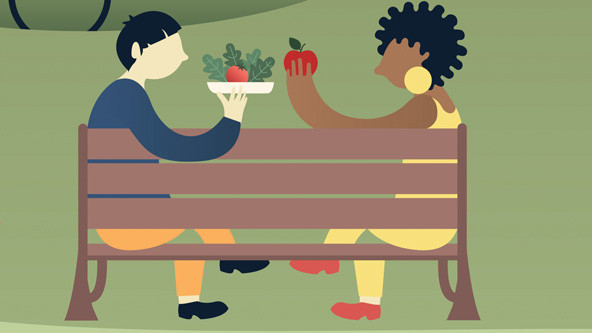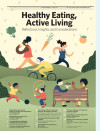 (Illustration by Chiara Zarmati)
(Illustration by Chiara Zarmati)
In the late 1990s, Public Health Advocates, a nonprofit organization that promotes health equity, began working to remove soda and junk food from California schools. The food and beverage industries fought these reforms, as schools had become ground zero for building brand loyalty. Yet studies confirmed an out-of-control childhood obesity epidemic, with schools becoming soda-and-junk-food superstores. This data, along with support from parents and other stakeholders, led to growth in support for public policy reforms. After long and contentious policy battles, California enacted statewide legislation in 2001, 2003, and 2005 to remove soda and junk food from schools. Over the next five years, more than 20 states followed California’s lead with similar legislation.
Healthy Eating, Active Living

This collection of articles, produced for Grantmakers In Health and supported by the Colorado Health Foundation, explores the latest thinking from health funders, researchers, and advocates on healthy eating and active living (HEAL) and healthy communities.
-
Healthy Eating, Active Living: Reflections, Insights, and Considerations for the Road Ahead
-
Healthy Eating and Active Living Through an Equity Lens
-
Connecting Health and Education So Children Can Learn and Thrive
-
The Future of Healthy Eating Research
-
How to Improve Physical Activity and Health for All Children and Families
-
The Colorado Health Foundation’s HEAL Evolution
-
How Market Forces Could Improve How We Eat
-
The Power of Business to Change Food Culture for the Better
-
Political Power as a Tool to Improve the Health of All Americans
-
Evaluate, Invest in Advocacy, and Shrink the Change
The tide had turned. In partnership with the Clinton Foundation, the three largest soda producers agreed to remove sugary drinks from schools. They bought national ads to celebrate their decision and eventually came to see that protecting the health of children not only was politically expedient but also made good business sense. Twenty years later, these once highly controversial policies are now mainstream.
As a public health advocate for the past 20 years, I have helped enact legislation at both state and local levels, promoting healthy eating and active living to mitigate the twin epidemics of obesity and diabetes. During this time, public health proponents and the food and beverage industries have often treated one another as enemies. Public health advocates frequently accuse the food and beverage industries of caring only about the bottom line, while the food and beverage industries often consider advocates to be “the food police” and say that eating well is strictly a matter of personal responsibility.
We have nevertheless made progress. Childhood obesity rates have plateaued in some communities, and there is growing evidence that public policies like those promoting healthy school food have a real impact. Still, the diabetes and obesity epidemics continue, disproportionately harming low-income communities and communities of color. Remarkably, more than half of US adults now have diabetes or prediabetes.
Finding common ground between health advocates and the food and beverage industries can save lives and prevent chronic disease across the nation. By pushing boundaries, changing expectations, and collectively questioning the status quo, we could forge a new era of mutual benefit.
Brand, image, and sales have always been the lifeblood of food and beverage companies. But today these companies find themselves in a bind. As Pulitzer Prize-winning reporter Michael Moss describes in his best-selling book, Salt Sugar Fat: How the Food Giants Hooked Us, high-calorie and processed foods are big sellers because we are biologically drawn to them. Companies scientifically formulate and market products that compel us to eat and drink them. By increasing the sugar content of Yoplait yogurt, General Mills saw sales soar. Likewise, beverage industry formulators aim for the “bliss point”—the precise amount of sweetness that induces the greatest cravings.
In Capitalism and Freedom, Nobel Prize-winning conservative economist Milton Friedman writes, “There is one and only one social responsibility of business … to increase its profits.” Importantly, Friedman qualifies this oft-quoted statement by adding, “so long as it stays within the rules of the game, which is to say, engages in open and free competition without deception or fraud.” Perhaps one place where health advocates and the food and beverage industries can work together is to ensure that consumers have more complete information about the products they purchase, so they are neither misled nor deceived.
For many years, those industries have claimed that the obesity and diabetes epidemics should not be addressed through public policy. In order to exercise this responsibility in a free market, however, consumers must have the information they need to make an informed purchase. Too often they do not, with products marketed to suggest that consuming them brings only fun and happiness. We must change the rules to ensure that consumers have information about the health effects of consuming harmful products.
Warning labels on sugary drinks are a good place to start. With 16 teaspoons of sugar in every 20-ounce fruit drink, energy drink, or soda, these beverages are the single largest source of sugar in the American diet. That sugar payload is absorbed by the body in as little as 30 minutes, taxing the pancreas and being stored in the liver as fat.
Warning labels would also aid competitiveness in the beverage industry. All manufacturers would have to play by the same rules, helping the industry to elevate its reputation by demonstrating its contribution to personal responsibility by providing consumers with science-based product information. Many major beverage companies already voluntarily post calorie information on the front of bottles and cans. Warning labels are the next logical step toward promoting the public’s health. The industry can get ahead of the curve by supporting this as public policy.
If the food and beverage industries take a long-term view, they will see that public policy is their safest path to maintaining market share while recapturing a sense of corporate responsibility. Just as the industry eventually came together to support removal of soda and junk food from schools nearly two decades ago, it can do the same with warning labels—without putting any single corporation at risk.
America’s business community is often reluctant to embrace public policy. But as consumers demand more corporate accountability and express greater concern about their health, public policy might be the smartest place for industry and health advocates to find common ground in seeking solutions.
Support SSIR’s coverage of cross-sector solutions to global challenges.
Help us further the reach of innovative ideas. Donate today.
Read more stories by Harold Goldstein.

